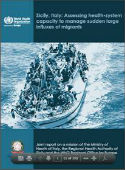Sicily, Italy: assessing health-system capacity to manage sudden large influxes of migrants. Joint report on a mission of the Regional Health Authority of Sicily and the WHO Regional Office for Europe, with the support of the Italian Ministry of Health

Download
2014, vii + 17 pages
ISBN 978 92 890 5070 8
This publication is only available online.
In response to influxes of migrants to the European Region, the WHO Regional Office for Europe and the Ministry of Health of Italy revised the WHO toolkit for assessing health systems’ capacity for crisis management in 2013. The Regional Office organized a mission to Sicily in October 2013 both to pilot-test the draft toolkit and to assess ongoing preparedness and response activities. This report presents the mission’s findings and recommendations.
The main public health concern identified is persistent overcrowding in migrant centres. This results in the poor hygienic conditions observed, to different degrees, in all the centres visited. In terms of emergency preparedness and response, interministerial coordination and several aspects of the existing health information system represent key leadership issues that need further strengthening. WHO can support the regional authorities in setting up sustainable regional mechanisms of preparedness for and response to influxes of migrants.
The assessment team made five key recommendations in need of urgent consideration by countries.
- Urgently establish and maintain minimum standards of living conditions in all existing types of migrant centre.
- Identify and map sites that are used or could be used as additional migrant centres and certify the adequacy of any site chosen as a migrant centre before using it.
- Improve coordination and the flow of information between the regional and provincial representatives of the interior and health ministries.
- Establish a common health information management system and revise the existing surveillance system.
- Define and implement a public health risk communication strategy.



